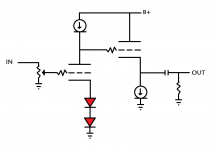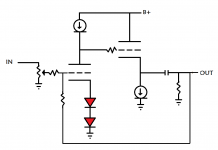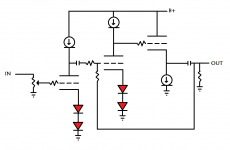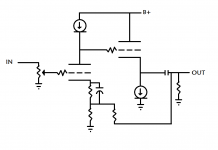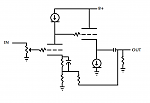I'm just checking in to see if there is a nice way to add global negative feedback to a circuit with the first stage led biased and the second stage a cathode follower. I'm not sure if you can add NFB to an LED biased driver stage or not, so I need some basic assistance as to whether this is possible?
Attached is a very generic schematic to show what I am working with.
Thanks for any help!
Attached is a very generic schematic to show what I am working with.
Thanks for any help!
Attachments
No reason not to change it to a cathode resistor, which should simplify things.
Yeah, it really does make it more simple. I just wasn't sure if there was any other way, other than changing the first stage bias (I'm a big fan of LED bias).
🙂
So am I, but there's places to use it and places where other things work better. This would be the latter.
How would you do that simple thing ?No reason not to change it to a cathode resistor, which should simplify things.
Why not let the leds be and do it like this ...
Mona
Attachments
I would like to know who the hell had the idea of use a led as a bias method.
Leds are good for illuminate panels but not to bias anything. Almost 6 decades of using resistors (a voltage proportional to a current transducer) as a bias for a tube has probe to be more than sufficient.
Also, a led varies his voltage drop with temperature, light and age. Very stupid IMHO for biasing a noble tube.
Leds are good for illuminate panels but not to bias anything. Almost 6 decades of using resistors (a voltage proportional to a current transducer) as a bias for a tube has probe to be more than sufficient.
Also, a led varies his voltage drop with temperature, light and age. Very stupid IMHO for biasing a noble tube.
I would like to know who the hell had the idea of use a led as a bias method.
Leds are good for illuminate panels but not to bias anything. Almost 6 decades of using resistors (a voltage proportional to a current transducer) as a bias for a tube has probe to be more than sufficient.
Also, a led varies his voltage drop with temperature, light and age. Very stupid IMHO for biasing a noble tube.
You're kidding, right? LEDs are great for producing bias because of the constant voltage they hold (and low noise, higher gain, etc). Even better when using a CCS in the anode of the tube.
Resistors are fine, just not my preferred source of bias (which is why I was asking about NFB with LED bias).
Last edited:
No, I'm writing seriously.
First, you don't need a constant voltage to bias a tube, you need a voltage proportional to the current, to have the quiescent point fixed or secured.
Second, a led is a direct biased junction, the great spread of voltages between units, which also varies with temperature and external illumination.
Is this a good thing for a wright bias? How do you do if need a voltage between one led drop and two? Use a 1 1/2 led? No sense for me.
First, you don't need a constant voltage to bias a tube, you need a voltage proportional to the current, to have the quiescent point fixed or secured.
Second, a led is a direct biased junction, the great spread of voltages between units, which also varies with temperature and external illumination.
Is this a good thing for a wright bias? How do you do if need a voltage between one led drop and two? Use a 1 1/2 led? No sense for me.
I prefer LED biasing in fist stage(s) for several reasons:who the hell... Very stupid
- very stable voltage drop, and actually just as much as I need it. With the latest approaches on MOSFET-filtered/stabilized B+ makes sense;
- varies? well, for the noble tubes use the high-quality LEDs, do not be $0.30 cheap;
- I like how it sounds.
The words "IMHO" and "stupid" do not come in same sentence... IMHO.
No, I'm writing seriously.
First, you don't need a constant voltage to bias a tube, you need a voltage proportional to the current, to have the quiescent point fixed or secured.
Second, a led is a direct biased junction, the great spread of voltages between units, which also varies with temperature and external illumination.
Is this a good thing for a wright bias? How do you do if need a voltage between one led drop and two? Use a 1 1/2 led? No sense for me.
1. Actually, constant voltage is exactly what you need if you don't want degeneration. The CCS load regulates the current.
2. The forward bias voltage is dependent on the materials and is very consistent unit-to-unit for LEDs of the same type.
3. You can use a different color of LED if the particular ones you have aren't quite what you want.
1. Actually, constant voltage is exactly what you need if you don't want degeneration. The CCS load regulates the current.
2. The forward bias voltage is dependent on the materials and is very consistent unit-to-unit for LEDs of the same type.
3. You can use a different color of LED if the particular ones you have aren't quite what you want.
On a more productive note, I was wondering your thoughts on this:
I assume grid NFB would be fine and not vary if the amp had two gain stages and you applied it to the grid of the second gain stage, as there would not be a volume control causing variance. This would make it possible to still use LED biasing, the downside being the requirement for two gain stages (which I'm no particularly fond of).
Or would using a higher gain tube, resister biased so you can use cathode NFB (thus only requiring one gains stage) be better?
Schematics included to show what I mean
Attachments
You might take a look at John Broskie's site; he has done loads of options with this kind of circuits.
You might take a look at John Broskie's site; he has done loads of options with this kind of circuits.
I love his site, and check it regularly, but didn't find the answers I was looking for there.
Well, before deciding on optimal topologies, perhaps you could outline what specifically this circuit is supposed to do. That might direct answers a bit better.
Well, before deciding on optimal topologies, perhaps you could outline what specifically this circuit is supposed to do. That might direct answers a bit better.
It's a headphone amp. I'm basically just trying to lower the output impedance a bit, since I'm not overly familiar with NFB use.
What's the headphone impedance, and what are the voltage levels you're looking for? Different approaches for, say, 300 ohms versus 16 ohms.
Your main issue is likely to be drive capability for low impedance phones, not output impedance.
Your main issue is likely to be drive capability for low impedance phones, not output impedance.
What's the headphone impedance, and what are the voltage levels you're looking for? Different approaches for, say, 300 ohms versus 16 ohms.
I wouldn't use NFB if I was going into high impedance headphones.
I don't think I need any help in the way of sourcing enough power, just some assistance on how to apply feedback since I'm fairly new to using it.
The headphones I'm using are 32 ohm, so I'll need around 20dB of feedback to get the output impedance to ~10R or less.
Your issue will be drive capability. 32 ohms is a pretty tough load for tubes driving directly unless you use a pretty large output tube for the cathode follower. You might consider using an output transformer and skipping the feedback idea.
Remember, low source impedance does NOT mean low distortion into low loads!
Remember, low source impedance does NOT mean low distortion into low loads!
- Status
- Not open for further replies.
- Home
- Amplifiers
- Tubes / Valves
- How to add Global NFB to a circuit with LED bias and cathode follower?
